Papers by Carlo Vandecasteele
Assessing the biomass based electricity potential of developing nations like Cuba can help to red... more Assessing the biomass based electricity potential of developing nations like Cuba can help to reduce the fossil fuels dependency and the greenhouse gas emissions. The data included in this study present the evolution of electricity production and greenhouse gas emissions in Cuba. Additionally, the potentialities to produce bio-mass based electricity by using the most significant biomass sources in Cuba are estimated. Furthermore, estimations of the potential reductions of greenhouse gas emissions, resulting from implementing the biomass based electricity potential of the different sources discussed in the study, are included. Results point to the most promising biomass sources for electricity generation and their potential to reduce GHG emissions.
Assessing the biomass based electricity potential of developing nations like Cuba can help to red... more Assessing the biomass based electricity potential of developing nations like Cuba can help to reduce the fossil fuels dependency and the greenhouse gas emissions. The data included in this study present the evolution of electricity production and greenhouse gas emissions in Cuba. Additionally, the potentialities to produce biomass based electricity by using the most significant biomass sources in Cuba are estimated. Furthermore, estimations of the potential reductions of greenhouse gas emissions, resulting from implementing the biomass based electricity potential of the different sources discussed in the study, are included. Results point to the most promising biomass sources for electricity generation and their potential to reduce GHG emissions.
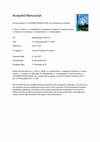
" Cleaner Production " (CP) is about less and more efficient energy and materials use and the sub... more " Cleaner Production " (CP) is about less and more efficient energy and materials use and the substitution of more harmful products (for the environment and health) by less dangerous ones. CP was the reply of the industry to the call for sustainable development as launched by the WCED (1987) and further elaborated in Rio's Agenda 21 (UN, 1992). During the past 25 years, the concept was put in practice. During this period it changed in scope, methods, and application area. This provided a deeper socioeconomic impact to an idea that was originally launched to awaken industry on its environmental responsibilities. This paper provides a review of essentials that contributed to the fundamental changes in CP during the most recent quarter of a century. It takes off with a review of CP definitions illustrating the changes of the content. Changes in scope are exemplified with the increasing importance of " Corporate Social Responsibility " (CSR). This includes that post-modern companies have not only responsibilities on their economic performance and the environment, but should also act on issues including human rights and resources, business ethics, and community involvement. The links between CP and green and circular economy are indicated. The CP approach is increasingly applied outside the industry. CP for sustainable tourism is discussed in more detail but is only an example of the wider application in e.g. agriculture or health services. This widening of contents necessitates more and better-adapted methods supporting the measurement of the CP components. Indicators, assessment strategies, and green accounting are increasingly improved and used more specifically and frequently. This evolution is discussed in a context of a dilution of the original environmental targets in a wider, more societal scope and the transition towards a more responsible, proactive and reliable management of the sectors applying CP.

" Cleaner Production " (CP) is about less and more efficient energy and materials use and the sub... more " Cleaner Production " (CP) is about less and more efficient energy and materials use and the substitution of more harmful products (for the environment and health) by less dangerous ones. CP was the reply of the industry to the call for sustainable development as launched by the WCED (1987) and further elaborated in Rio's Agenda 21 (UN, 1992). During the past 25 years, the concept was put in practice. During this period it changed in scope, methods, and application area. This provided a deeper socioeconomic impact to an idea that was originally launched to awaken industry on its environmental responsibilities. This paper provides a review of essentials that contributed to the fundamental changes in CP during the most recent quarter of a century. It takes off with a review of CP definitions illustrating the changes of the content. Changes in scope are exemplified with the increasing importance of " Corporate Social Responsibility " (CSR). This includes that post-modern companies have not only responsibilities on their economic performance and the environment, but should also act on issues including human rights and resources, business ethics, and community involvement. The links between CP and green and circular economy are indicated. The CP approach is increasingly applied outside the industry. CP for sustainable tourism is discussed in more detail but is only an example of the wider application in e.g. agriculture or health services. This widening of contents necessitates more and better-adapted methods supporting the measurement of the CP components. Indicators, assessment strategies, and green accounting are increasingly improved and used more specifically and frequently. This evolution is discussed in a context of a dilution of the original environmental targets in a wider, more societal scope and the transition towards a more responsible, proactive and reliable management of the sectors applying CP.

The outcome of Life Cycle Assessment (LCA) studies is strongly influenced by the selection of the... more The outcome of Life Cycle Assessment (LCA) studies is strongly influenced by the selection of the functional unit, which must be defined in such a way that, when products are compared, the amounts compared have identical utilities. LCA studies of cements mostly use mass based functional units (MFU). However, since different cements have a different composition and binding capacity, they result in different compressive strength and durability in their applications, so that MFUs are inadequate. Therefore, this study introduces as functional unit the Cement Functional Performance (CFP): mass of cement needed to obtain 1 MPa of compressive strength during one year of durability (kg/(MPa • year)). To evaluate the effect of the CFP, the environmental performance of three cements is compared. Results show that adding 5% of zeolite to cement results in a similar strength and 1.78 times higher durability of the produced concrete, which is explained by the reduction of chloride diffusion. Moreover, adding 19% of zeolite to cement increases its durability 2.75 times, but reduces compressive strength by 29%. As a result, cement with 5 and 19% of zeolite added has respectively 54 and 36% of the environmental impacts of Portland cement.

The outcome of Life Cycle Assessment (LCA) studies is strongly influenced by the selection of the... more The outcome of Life Cycle Assessment (LCA) studies is strongly influenced by the selection of the functional unit, which must be defined in such a way that, when products are compared, the amounts compared have identical utilities. LCA studies of cements mostly use mass based functional units (MFU). However, since different cements have a different composition and binding capacity, they result in different compressive strength and durability in their applications, so that MFUs are inadequate. Therefore, this study introduces as functional unit the Cement Functional Performance (CFP): mass of cement needed to obtain 1 MPa of compressive strength during one year of durability (kg/(MPa • year)). To evaluate the effect of the CFP, the environmental performance of three cements is compared. Results show that adding 5% of zeolite to cement results in a similar strength and 1.78 times higher durability of the produced concrete, which is explained by the reduction of chloride diffusion. Moreover, adding 19% of zeolite to cement increases its durability 2.75 times, but reduces compressive strength by 29%. As a result, cement with 5 and 19% of zeolite added has respectively 54 and 36% of the environmental impacts of Portland cement.

Hotels are among the most energy intensive tourism facilities. To monitor and control the monthly... more Hotels are among the most energy intensive tourism facilities. To monitor and control the monthly and yearly energy consumption in hotels, different indicators have been proposed. These indicators, developed on yearly or annual basis, do not permit rapid detection and mitigation of malpractices and overconsumptions in hotel facilities. Moreover, these indicators do not consider the influence of physical parameters such as outdoor temperature, or, when they do, rather complex coefficients are used, precluding implementation in hotel facilities. This study discusses the use of Energy Performance Indicators to assess and control the electricity consumption in hotels. To this end a new indicator considering the outdoor temperature is introduced. Based on this indicator daily control graphs are developed, allowing a more rapid detection of overconsumptions and malpractices towards a higher electricity efficiency. One advantage of this approach is that no investments are required to implement it. The tools were implemented in two Cuban hotels of different characteristics, where reductions of the electricity consumption in 2014 compared to 2013 of 10 and 11%, were achieved.
A quantitative assessment of the environmental impact of construction activities is useful to ide... more A quantitative assessment of the environmental impact of construction activities is useful to identify the main environmental impacts and to improve their environmental footprint. This study presents the life cycle assessment of an earthwork project. The results show that earthwork activities entail important environmental impacts; mainly energy consumption, global warming and human toxicity. This study proposes and implements cleaner production strategies, based on the hierarchy of waste management, to improve the environmental performance of the earthwork project. The approach allows reducing the amount of soil to be used by the earthwork project. Moreover both the diesel consumption and the greenhouse gas emissions can be reduced by about 41%. This coincides with a saving of about 1.76 million dollars.
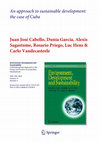
Abstract This paper analyzes the Cuban model of sustainable development and explains the causes t... more Abstract This paper analyzes the Cuban model of sustainable development and explains the causes that made Cuba the only country that meets the conditions of sustainability according to the Worldwide Fund for Nature (WWF). The Human Development Index has three main components: quality of life (health indicator measured as life expectancy at birth), knowledge (education indicator measured as adult literacy) and the standard of life (economic indicator measured by the Gross Domestic Income). This paper analyses the aspects of the educational and health system of Cuba and also of its energy policies that
explain the excellent scores of the Human Development Index. Cuba shows a Human
Development Index of 0.8 with an Ecological Footprint of 1.8 gha. This is achieved with a
Gross Domestic Income lower than other countries with similar Human Development Index. The Ecological Footprint of Cuba is mainly determined by the CO2 and the agricultural land footprint. The paper shows how the economic transition, after the economic crisis of the early 1990s, was realized without significantly increasing the Ecological
Footprint.

As pork is indispensable in the diet of Cuban people, the government was forced to prioritize its... more As pork is indispensable in the diet of Cuban people, the government was forced to prioritize its production. Pig production causes several environmental impacts related with air, water and soil pollution, which can be quantified with the application of Life Cycle Assessment that allows to optimize products and processes by identifying their environmental impacts. Farming systems considered in different Life Cycle Assessment studies show substantial differences in their characteristics, namely: animal productivity , feed composition, manure management and production period, which influences the environmental performance of each system. Therefore, each study is unique for the system it assesses and should be analyzed individually. In Cuba, the environmental implications of pig production, whose understanding is cornerstone to eventually adopt more environmentally sound practices while ensuring high productivity standards, are yet to be quantified. This study provides some fundamental insights in the life cycle of pig production in the province of Cienfuegos. The assessment if focused in large farms of the province of Cienfuegos which causes large environmental impacts. Large farms accounts for the production of 77% of the pigs delivered to slaughter houses in the province. Pig production in Cienfuegos accounts for 7e12% of Cuban production. The quantification of the environmental impacts of pig production resulted in an impact per finished pig of 120 kg of live weight of 1892 MJ abiotic depletion of fossil fuels, 1019 kg-CO 2-eq. global warming potential , 36 kg 1.4-dichlorobenzene-eq. human toxicity, 17 kg 1.4-dichlorobenzene-eq. terrestrial toxicity, 1 kg 1.4-ethylene-eq. photo-oxidant formation, 12 kg-SO 2-eq. acidification potential and 6 kg PO 4-eq. eutrophication potential. It appeared that the main opportunities to improve the environmental performance of pig production in Cienfuegos are reduction of the impacts of the anaerobic lagoons used for manure management on global warming potential, acidification potential and eutrophication and the impact on acidification potential of pig housing. Direct land spreading of manure appears as the best alternative to lagooning, considering the current situation of pig breeding in Cienfuegos.

Journal of Material Cycles and Waste Management, 2012
The technical properties of cement mortars containing natural fine aggregate that is replaced by ... more The technical properties of cement mortars containing natural fine aggregate that is replaced by lead blast furnace slag at 25 and 35% level were assessed at fixed water-to-cement (W/C) ratio and at fixed flow table value. The leachabilities of some toxic elements from the cement mortars were also assessed to test the environmental suitability of the slag for use in preparation of cement mortar. At fixed W/C ratio, the strength of the mortar decreased with increase of the slag content. On the other hand, at fixed consistency, strength increased with increasing slag content in the mortar composition. The concentrations of some toxic elements in the leachates collected from the mortars containing slag were slightly higher than for the control mortar, but the concentrations in the leachates remained within the regulatory limits for recycling in construction applications. For most elements, leaching from a mortar containing 35% of slag was similar to that from a mortar containing 25% of slag. Therefore, 35% of natural sand can be beneficially replaced with Pb slag to produce cement mortar without affecting the mechanical and leaching properties studied in this work.
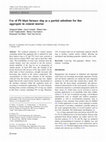
Journal of Material Cycles and Waste Management, 2012
The technical properties of cement mortars containing natural fine aggregate that is replaced by ... more The technical properties of cement mortars containing natural fine aggregate that is replaced by lead blast furnace slag at 25 and 35% level were assessed at fixed water-to-cement (W/C) ratio and at fixed flow table value. The leachabilities of some toxic elements from the cement mortars were also assessed to test the environmental suitability of the slag for use in preparation of cement mortar. At fixed W/C ratio, the strength of the mortar decreased with increase of the slag content. On the other hand, at fixed consistency, strength increased with increasing slag content in the mortar composition. The concentrations of some toxic elements in the leachates collected from the mortars containing slag were slightly higher than for the control mortar, but the concentrations in the leachates remained within the regulatory limits for recycling in construction applications. For most elements, leaching from a mortar containing 35% of slag was similar to that from a mortar containing 25% of slag. Therefore, 35% of natural sand can be beneficially replaced with Pb slag to produce cement mortar without affecting the mechanical and leaching properties studied in this work.

Sugar from sugarcane represents 65-70% of the world production of sugar and its production is mai... more Sugar from sugarcane represents 65-70% of the world production of sugar and its production is mainly located in developing countries. The production process requires high amounts of steam and electricity at the different stages, and generates important quantities of residues. A major residue of the sugar production is filter cake (in Cuba: Cachaza), the residue from cane juice filtration. Filter cake causes significant pollution, and in several sugar factories it is considered a waste, posing problems of management and final disposal. This paper reviews recycling and recovery opportunities of filter cake (and bagasse) and experimentally studies the use of filter cake as fuel at the sugar factory. Filter cake may e.g. be used as a fertilizer/soil improver directly applied on the fields or after composting. During its decomposition, it generates, however, an acid leachate and emits significant amounts of greenhouse gases. Moreover, the experimental part of the paper shows that blends of filter cake with bagasse can be combusted in industrial boilers in sugar factories, and that loose, non-vitrified ashes with a similar appearance as bagasse ash are obtained. This results in lower volumes and masses of residues to be transported, so that transportation costs are reduced. Moreover, it gives a new economic value to the filter cake, and reduces its environmental impact. When all filter cake would be combusted blended with bagasse, about 25% more ash would be obtained than for bagasse and the trace element composition would comply with the regulatory limits for use as fertilizer/soil improver.
Key Engineering Materials, 2002
Science of The Total Environment, 1997
The influence of Cd application on the growth and various biochemical processes in Mung bean (Pha... more The influence of Cd application on the growth and various biochemical processes in Mung bean (Phaseolus aureus Roxb.) seedlings was studied quantitatively. Applied cadmium reduced the growth of roots (endogenous toxic threshold value of 25 μg/g dry wt.), the growth of ...
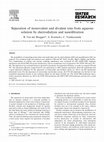
Water Research, 2004
The possibilities of separating monovalent and multivalent ions by electrodialysis (ED) and nanof... more The possibilities of separating monovalent and multivalent ions by electrodialysis (ED) and nanofiltration (NF) are explored. Five synthetic single salt solutions were applied to ED and NF: NaCl, Na(2)SO(4), MgCl(2), MgSO(4) and NaNO(3). Two combinations of anionic and cationic exchange membranes were evaluated for ED (AMV/CMV Selemion membranes and ACS/CMS Tokuyama membranes), and two membranes were evaluated for NF (NTR 7450 and UTC-60). The separation was evaluated using an alternative parameter, the separation efficiency, in order to compare ED and NF. The separation efficiency ranges from 0% (no separation) to 100% (perfect separation). Both NF membranes had a good separation efficiency for the separation of monovalent and divalent anions (ca. 60%); the ED membranes performed worse. For the separation of monovalent and divalent cations, the UTC-60 membrane was the best for the considered separation because of size exclusion effects for the larger divalent ion. The ACS/CMS membranes had a similar separation efficiency (ca. 60%); the NTR 7540 membrane and AMV/CMV ED membranes showed only a small separation.

Water Science & Technology, 2008
In the carwash industry, water recycling is necessary to be in accordance with present and upcomi... more In the carwash industry, water recycling is necessary to be in accordance with present and upcoming environmental laws. As this is not possible with traditional techniques, membrane processes (like ultrafiltration (UF) and nanofiltration (NF)) are technically and economically evaluated in this study. Concerning the technical part, there needs to be a compromise between a high permeate permeability on the one hand and a high permeate purity on the other hand. Depending on the use of the purified wastewater, ultrafiltration (to recycle wastewater in the main wash cycle) or nanofiltration (to recycle wastewater in the rinsing step) would be the optimal choice. Concerning the financial part, the implementation of membrane processes in the wastewater purification installation is economically feasible, especially when expensive tap water is used as pure water. These positive evaluations imply that membrane processes can be useful to recycle wastewater in the carwash industry, on condition that the right membrane type (with the least membrane fouling) and the right process format (e.g., hybrid process of UF and/or NF with a biological treatment) is selected.
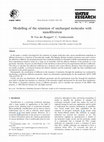
Water Research, 2002
In this paper, a model is developed for the retention of organic molecules with a given nanofiltr... more In this paper, a model is developed for the retention of organic molecules with a given nanofiltration membrane at different pressures as a function of the molecular weight. The Spiegler-Kedem transport equations were used to derive the reflection coefficient, the maximal retention that would theoretically be obtained at infinite transmembrane pressure, from experimental retention values for a large set of molecules with the effective diameter of the molecule as a size parameter. Secondly, the pore size distribution of the membrane is derived from the experimental reflection coefficients. This allows to calculate the reflection coefficient for a molecule with a given effective diameter. Since this parameter is not readily available, a correlation between the effective diameter and the molecular weight has been established and introduced in the model equations. Subsequently, the contribution of diffusion in the transport of molecules through the membrane was evaluated by introducing a membrane diffusion parameter, which was determined experimentally for the membranes NF70, NTR 7450 and UTC-20. Finally, the pore size distribution, the diffusion parameter and the experimental water flux through the membrane were used to calculate the retention as a function of the molecular weight and pressure for the same three membranes. This allows to determine retention curves at different pressures, and to calculate the variation of the MWC with pressure.

Water Research, 2004
The brewing industry is a large consumer of groundwater for brewing, rinsing and cooling purposes... more The brewing industry is a large consumer of groundwater for brewing, rinsing and cooling purposes. As regulations become more and more stringent and the cost of water increases, water recycling gains interest. This paper investigates the possibilities of nanofiltration for the treatment of brewery waste water streams in view of recycling. Four different water streams (waste water after biological treatment, bottle rinsing water, rinsing water of the brewing room and rinsing water of the bright beer reservoir) were filtered with four different nanofiltration membranes (UTC-20, UTC-60, Desal-HL-51 and Desal-5-DK). The results for the biologically treated waste water were the most promising. For the other streams, rejection of organics was insufficient to obtain the required quality, mainly due to the high concentrations of organics such as ethanol in the feed water. Over the periods considered (3 h) only moderate flux decline (10-40%) was observed for most membranes and feed solutions. For Desal-5-DK at high pH, an increase of the flux was observed.

Waste Management, 2000
Combustion residues in general and MSWI¯y ashes in particular form a major environmental problem ... more Combustion residues in general and MSWI¯y ashes in particular form a major environmental problem as they are polluted with heavy metals. The heavy metals can be removed from the¯y ash by leaching with e.g. the acid wastewater obtained in the wet scrubber of the air pollution control system. The remaining¯y ash can be land®lled or valorized e.g., a construction material. An understanding of the leaching reactions and of the factors that in¯uence leaching is very important for the treatment of¯y ash. Therefore, the composition of the¯y ash was determined and the in¯uence of pH was examined. In this paper, the results of experimental leaching tests of¯y ash are compared with computer calculations of the thermodynamic equilibrium of the leaching solution±¯y ash system. The computer program MINTEQA2, used for this purpose, allows to predict the metal concentrations in the leaching solution, the minerals that precipitate, and the pH of the leaching solution at equilibrium. Also a sequential extraction procedure was performed on the¯y ash. The procedure can be used to investigate which leaching conditions are necessary to obtain a good extraction of the heavy metals. Comparison of the experimental and calculated leaching data with the results from the sequential extraction procedure allowed verifying the accuracy of the sequential extraction procedure. #







Uploads
Papers by Carlo Vandecasteele
explain the excellent scores of the Human Development Index. Cuba shows a Human
Development Index of 0.8 with an Ecological Footprint of 1.8 gha. This is achieved with a
Gross Domestic Income lower than other countries with similar Human Development Index. The Ecological Footprint of Cuba is mainly determined by the CO2 and the agricultural land footprint. The paper shows how the economic transition, after the economic crisis of the early 1990s, was realized without significantly increasing the Ecological
Footprint.
explain the excellent scores of the Human Development Index. Cuba shows a Human
Development Index of 0.8 with an Ecological Footprint of 1.8 gha. This is achieved with a
Gross Domestic Income lower than other countries with similar Human Development Index. The Ecological Footprint of Cuba is mainly determined by the CO2 and the agricultural land footprint. The paper shows how the economic transition, after the economic crisis of the early 1990s, was realized without significantly increasing the Ecological
Footprint.